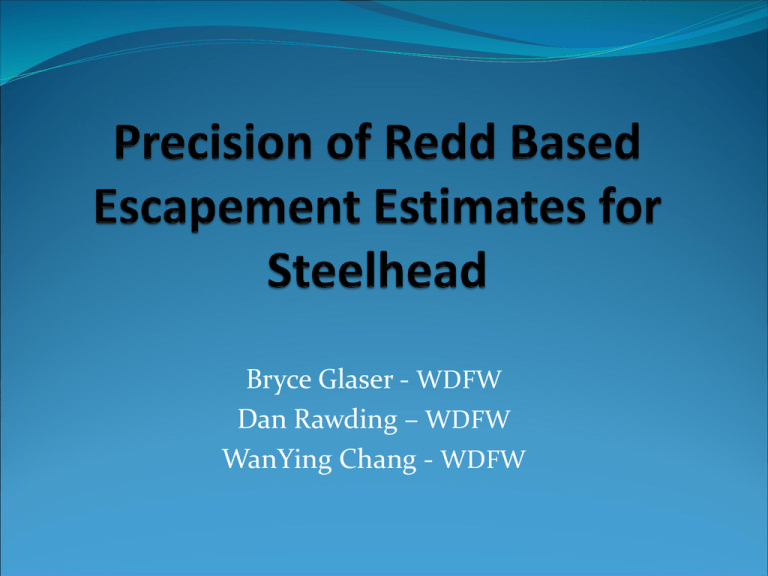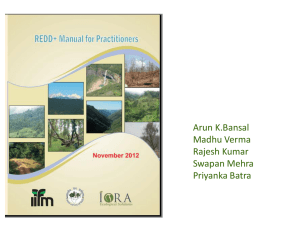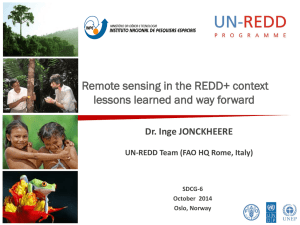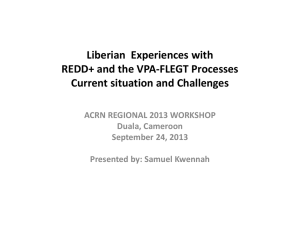
Bryce Glaser - WDFW
Dan Rawding – WDFW
WanYing Chang - WDFW
OVERVIEW
WDFW Steelhead Escapement Estimation
Methodologies
Focus on Redd Surveys
Precision Goals for Monitoring
Sources of Uncertainty in Redd Surveys
Examples of Precision in LCR Estimates
Conclusion/Implications
WDFW Steelhead Escapement
Redd surveys - the most common method of
estimating escapement used by WDFW.
Census Counts - when possible weirs and/or barriers
are used to census steelhead.
Mark–Recapture - in other cases weirs, fish ladders,
seining and/or snorkeling are used for mark-recapture
programs.
Why Redd Surveys?
Tradition
Ease of implementation.
Relatively inexpensive/Cost Effective.
Provide a straight forward estimate of females.
Provide an estimate of spawners, not run size as
from mark-recapture.
Other escapement methodologies may be more
difficult.
Provide the ability to estimate fine scale spatial
structure if redd locations are GPS’d.
Downside to Redd Surveys:
Relatively Imprecise
Salmon & Steelhead Escapement
Accuracy
Method
Sampling
Design
Census
Complete
Mark-Recapture
Peak/Supplemental
Area-Under-the-Curve
Peak Count Expansion
Random
Redds
Index
Cost
Redd Count Expansion
Redd
Count
# of Females
×
×
Females
/ Redd
Adults/Female
(Sex Ratio)
═
═
# of Females
Spawner
Escapement
Estimate
Redd Count Expansion
Redd
Count
×
Fish /
Redd
═
Spawner
Escapement
Estimate
Redd Surveys
Calibrated Survey –
Escapement estimate and sex ratio is obtained from a weir
or mark-recapture program.
Females or fish per redd = Estimated #of females or
fish/redd estimate.
In years of no trapping or mark-recapture - the redd
estimate is expanded by the females per redd estimate
and sex ratio or simply by fish per redd to estimate
escapement.
Partially Calibrated Survey –
Estimate of females per redd and sex ratios, or fish per
redd obtained from another basin is used to expand the
redd estimate for the population of concern.
Uncalibrated Survey –
professional judgment is used to estimate females or fish
per redd.
Assumptions
Calibrated Redd Surveys
Redds are consistently identified and enumerated.
Observer efficiency is incorporated into the females per redd
estimate.
Partially Calibrated Redd Surveys
Above assumptions plus…..
Fish or females per redd estimate and observer efficiency is the
same for the source population (calibrated) & the population
where applied (partially calibrated surveys).
Spatial distribution of spawning is known.
Temporal spawning pattern is known.
A statistically valid spatial and temporal study design is
established if survey is not a census.
Precision Goals for Monitoring
NOAA’s Draft Guidance for Monitoring Recovery of
Pacific Northwest Salmon and Steelhead (Crawford &
Rumsey 2009)
CV on average of 15% or less for adult abundance.
Robson & Regier (1964)
Research Goal: 95% CI of + 10% of point estimate.
Management goal: 95% CI of + 25% of point estimate.
Cousens et al. (1982)
95% CI of + 20% of point estimate – considered to be good.
Sources of Uncertainty
Females/Redd
WDFW standard methodology - Snow Creek data.
Sex Ratios
WDFW standard methodology – Assumes 1:1 ratio.
Kalama River data
Sampling Design
Census – Example - Mill, Abernathy, Germany creeks
Index/Supplemental – Examples - Coweeman and Elochoman
rivers.
Generalized random tessellation stratified (GRTS)
sampling
Females per Redd
Snow Creek Steelhead, 1977-89
Females per Redd
1.4
Slope = 0.001
Ho: slope = 0, not rejected
p - value = 0.545
0.9
0.4
0
10
20
30
Number of Females
40
50
60
Snow Creek estimate based on calibrated redd surveys compared to the weir
count of females from 1977-89.
Mean =0.804, SD = 0.152, CV = 19%
Females per redd is constant over the range of escapement.
Sex Ratio
WDFW has historically used a 1:1 sex ratio for
expansions (= 2 fish per female).
Kalama Winter Steelhead - Fish per female
Kalama Falls Hatchery – operates a fish ladder trap and
barrier falls.
Mean fish per female = 1.85 (54% females, 46% males).
SD = 0.109, CV = 6%
Assume sex ratio is constant regardless of run size.
Sampling Design
Census
Entire spawning area is surveyed
Index/Supplemental
Indices in mainstem and tributaries are surveyed.
At peak spawning time in index, a supplemental survey
occurs in the remainder of the spawning area.
Test for differences in % redds visible in tributaries vs.
mainstem at the time of supplemental survey.
Supplemental survey counts are expanded based on %
redds visible in index areas.
Generalized random tessellation stratified (GRTS)
Spatially balanced designs (EMAP)
Escapement Estimates from Census
Mill, Abernathy and Germany Creeks
2008
Escapement Estimates from Census
• Sampling design is census: CV= 0
• Uncertainty from Females/Redd and Sex Ratio
• CV = 20%; equivalent to 95% CI + 40%
Name
Esc
SD(esc)
CV(esc)
L95%CI
U95%CI
Mill
34
6.8
20%
21
47
Abernathy Germany
223
228
44.2
45.1
20%
20%
136
139
310
316
MAG
485
96.1
20%
296
673
Index/Supplemental –Coweeman River
Index/Supplemental –Coweeman River
Sampling Design – Index/Supplemental: CV = 17%
Uncertainty from sampling design, females/redd and
sex ratio: CV=26%; 95% CI + 51%
Escapement Estimate: 631
14% of the redds were in index surveys
86% of redds were in supplemental surveys
Test for differences in mainstem vs. trib. indices.
separate timing expansion for tributaries and mainstem was
necessary (Chi-square test, p=0.013)
Index/Supplemental –Elochoman River
Index/Supplemental –Elochoman River
• Sampling Design – Index/Supplemental: CV = 5%
• Uncertainty from sampling design, females/redd and sex
ratio: CV=20%; 95% CI + 40%
• Escapement Estimate: 286
• 42% of the redds were in index surveys
• 58% of redds were in supplemental surveys
• Test for differences in mainstem vs. trib. indices.
• no difference (Chi-square test p=0.97)
• single timing expansion.
General random tessellation stratified
(GRTS) designs
Used extensively in Oregon
Advantage – provides unbiased estimate
ODFW Targeted Sampling Rate to achieve CV ≤ 15%
Hypothetical Example:
ODFW Targeted Sampling: CV = 15%
WDFW Females per Redd: CV = 19%
WDFW (Kalama) Sex Ratio: CV = 6%
Escapement CV=
24%, 95% CI + 49%
Precision Comparison
Sampling
Design
Census
MAG
CV
20%
95% CI + 40%
Index/Supp. Index/Supp.
Coweeman Elochoman
GRTS
26%
20%
24%
+ 51%
+ 40%
+ 49%
Summary
Redd surveys are inexpensive, but also imprecise
compared to other methods.
Largest source of variation in redd based
escapement estimates is from females or fish per
redd estimates.
Smallest source of variation is from sex ratios.
CV for spatial sampling designs depends on effort.
Escapement CV ranges from 20% for a census, to
~25% for GRTS and index/supplemental designs.
Summary
If redd surveys are to be used to estimate
escapement, WDFW needs additional
calibrated studies to better estimate females or
fish per redd.
If redd based escapement estimates are not able
to meet established ESA, Research and/or
management precision goals for key
populations, then alternate escapement
methods should be considered.
Mark-recapture or weirs for selected steelhead
populations
Possibly the use of imaging sonar for steelhead.
Acknowledgements
Funding for LCR surveys:
NOAA via Mitchell Act funds
Washington State Salmon Recovery Funding Board
Thom Johnson & Randy Cooper - Snow Cr. data.
Cameron Sharpe and Kalama Research Team Kalama R. data.
Biologists and technicians that conducted redd
surveys.
Literature Cited
Cousens, N.B.F., G.A. Thomas, C.G. Swann, and M.C. Healy. 1982. A review
of salmon escapement estimation techniques. Canadian Technical Report of
Fisheries and Aquatic Sciences. 1108.
Crawford, B. A. and S. Rumsey. 2009 (Draft). Guidance for monitoring
recovery of Pacific Northwest salmon and steelhead listed under the Federal
Endangered Species Act (Idaho, Oregon, and Washington). NOAA’s
National Marine Fisheries Service – Northwest Region, Portland, OR.
Robson, D.S., and H.A. Regier. 1964. Sample size in Petersen mark-recapture
experiments. Transactions of the American Fisheries Society 93: 215-226.










